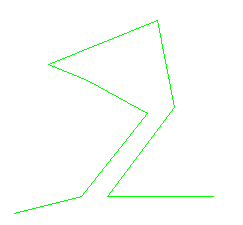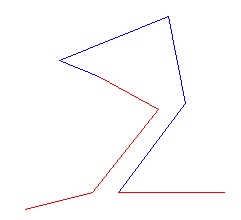Input lines for generalization. They are assumed to not self-intersect or intersect with another line or point.
Uses the Sherbend algorithm to simplify lines by reducing unnecessary details based on the analysis of the line’s bends.
Sherbend is a constraint-based algorithm that preserves the spatial relationship of the lines and points in the input data. The Sherbend algorithm iteratively generalizes the bends in a line by using the Diameter parameter to select bends for generalization. The generalization process may eliminate, reduce, or combine bends, while resolving conflicts.
The strategy for generalizing bends in a line is as follows:
Input lines for generalization. They are assumed to not self-intersect or intersect with another line or point.
Input points for the sidedness constraint. When the “Sidedness” constraint is enabled, these points will prevent a bend generalization if that would change the spatial relationship between the bend and the points.
The generalized lines.
Bends that, if generalized, would violate the selected constraint.
Invalid input features will be output to the Invalid port.
Only lines and points in the same group are subject to constraint checking. If no group is specified, all lines and points are placed in the same group.
Note: How parallel processing works with FME: see About Parallel Processing for detailed information.
This parameter determines whether or not the transformer should perform the work across parallel processes. If it is enabled, a process will be launched for each group specified by the Group By parameter.
For example, on a quad-core machine, minimal parallelism will result in two simultaneous FME processes. Extreme parallelism on an 8-core machine would result in 16 simultaneous processes.
You can experiment with this feature and view the information in the Windows Task Manager and the Workbench Log window.
No: This is the default behavior. Processing will only occur in this transformer once all input is present.
By Group: This transformer will process input groups in order. Changes on the value of the Group By parameter on the input stream will trigger batch processing on the currently accumulating group. This will improve overall speed if groups are large/complex, but could cause undesired behavior if input groups are not truly ordered.
This parameter specifies the diameter of the reference circle (described at the beginning of this documentation), which roughly describes the width of a bend below which the bend will be generalized. Different lines can have different diameters specified as an attribute. The bigger the diameter, the more likely bends will be generalized.
Enables spatial constraints, which are only applied to lines and points in the same group.
In this diagram, the blue bend cannot be generalized as it would violate the “Sidedness” constraint:

In this diagram, the blue bend cannot be generalized as it would violate the “Self Intersection” constraint:


This parameter, if set to No, will re-order (rotate) the coordinate list of each closed line in an attempt to improve the quality of generalization. To preserve juncture connectivity, the transformer must ensure that the starting and end coordinates of every line are kept stationary. Therefore, if it is important to keep the positions of the first and last coordinates in a closed line (perhaps because they are on a juncture), this parameter should be set to Yes.
If this parameter is set to Yes, the endpoints of a line will not be moved. This behavior allows the preservation of juncture connectivity.
In this example, a bend is reduced (green = input, red = output):

In this example, a bend is eliminated:

In this example, three bends are combined into one:

The following diagram illustrates the generalization process on a single line in a real-world dataset:

This example illustrates the generalization process on a set of contours:

The aim of line generalization is to reduce the details on a line for representation at a smaller scale. While the well-known Douglas-Peucker algorithm, is good at reducing the number of points in a line, it is not so good at removing unnecessary details in a line. The Generalizer transformer contains a selection of algorithms under its parameters including the Douglas-Peucker algorithm.
In comparison, the Sherbend algorithm is well suited for the generalization of natural features (contours, lakes, rivers, wooded areas, etc.) because it preserves the general shape of the line. Moreoever, if spatial constraints are enabled, the spatial relationship between the input entities are preserved. The Douglas-Peucker algorithm with a small tolerance is often used before or after Sherbend to further reduce the number of points to further fulfill the goals of generalization.
Using a set of menu options, transformer parameters can be assigned by referencing other elements in the workspace. More advanced functions, such as an advanced editor and an arithmetic editor, are also available in some transformers. To access a menu of these options, click  beside the applicable parameter. For more information, see Transformer Parameter Menu Options.
beside the applicable parameter. For more information, see Transformer Parameter Menu Options.
Search for samples and information about this transformer on the FME Knowledge Center.